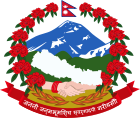- Nepalese governmental system referendum, 1980
-
Nepal 
This article is part of the series:
Politics and government of
NepalGovernment Political history · Constitution Executive President
Ram Baran YadavVice President
Parmanand JhaPrime Minister
Baburam BhattaraiCouncil of Ministers (List) Parliament Constituent Assembly Chairman
Subash Chandra NemwangVice Chairman
Purna Kumari SubediJudiciary Supreme Court Chief Justice
Khil Raj RegmiElections Election Commission
Constituent Assembly: 2008
Presidential: 2008Political parties Administrative divisions Capital
Regions
Zones
Districts
VDCs
A referendum on the system of government was held in Nepal on 2 May 1980. Voters were offered the choice between a non-partisan panchayat system and a multiparty system. The panchayat system received a slim majority of 54.8%. Voter turnout was 66.9%.[1]
Contents
Background
With the backdrop of mass student protests against his rule in the spring of 1979, King Birendra made a public declaration on May 23, 1979 that a referendum with universal adult suffrage with secret vote would be held in which the people of Nepal would be able to choose between introducing a multiparty system or retain the non-party panchayat regime.[2]
On 21 January 1980, King Birendra published the Referendum Rules, stating that after the referendum 'His Majesty shall make such provisions in the Constitution of Nepal as may deem necessary'.[3]
Method of voting
Nepalese citizens aged 21 and above were eligible to vote.[4] The voters would mark their choice by stamping either of two colours on the ballot paper, blue for the multiparty system and yellow for the non-party panchayat system. It was speculated at the time that the choice of colours had not been coincidental, since the yellow colour was associated with saintly religious qualities. There is no empirical evidence though, that the choice of colours affected the outcome of the vote.[5]
Results
Choice Votes % Panchayat 2,433,452 54.8 Multi-party 2,007,965 45.2 Invalid/blank votes 372,069 - Total 4,813,486 100 Source: Nohlen et al., Rishikesh By region
Choice Hills Inter-Tarai Mountains Plains Votes % Votes % Votes % Votes % Panchayat 1,126,169 57.2 87,895 34.0 228,617 71.1 848,754 44.6 Multi-party 844,124 48.8 139021 66.0 86,658 28.9 93,8162 55.4 Invalid/blank votes 158,581 - 20,645 - 25,061 - 69,041 - Total 2,127,615 100 278,780 100 340,338 100 2,066,753 100 Source: Rishikesh The panchayat partyless system option got a majority in 54 out of the 75 districts of Nepal. The highest percentage of pro-panchayat votes was recorded in Dolpo (96.4%), the lowest in Bhaktapur (34.4%). The highest scores for the multiparty system option were recorded in Bhaktapur (65.6%), Udaipur (65.1%), Siraha (64%) and Bardiya (62.1%). In general, the multiparty system option performed better in areas with higher literacy levels.
The Hindu community was more or less evenly divided between the two options. The Muslim community is said to have voted predominately in favour of the panchayat system. Ethnic groups like Tamang, Sherpa, Magar, Gurung and Kirati overwhelmingly supported the panchayat option, whilst the Tharu are said to have been predominately in favour of the multiparty system.[6]
References
- ^ Nohlen, D, Grotz, F & Hartmann, C (2001) Elections in Asia: A data handbook, Volume I, p633 ISBN 019924958
- ^ Shaha, Rishikesh. Politics in Nepal 1980-1990. New Delhi: Manohar Publications, 1990. p. 51, 69.
- ^ Shaha, Rishikesh. Politics in Nepal 1980-1990. New Delhi: Manohar Publications, 1990. p. 62.
- ^ Shaha, Rishikesh. Politics in Nepal 1980-1990. New Delhi: Manohar Publications, 1990. p. 80.
- ^ Shaha, Rishikesh. Politics in Nepal 1980-1990. New Delhi: Manohar Publications, 1990. p. 68-69.
- ^ Shaha, Rishikesh. Politics in Nepal 1980-1990. New Delhi: Manohar Publications, 1990. p. 69-70.
Parliamentary elections Referendums 1980Categories:- Elections in Nepal
- 1980 referendums
- 1980 in Nepal
- Referendums in Nepal
Wikimedia Foundation. 2010.
